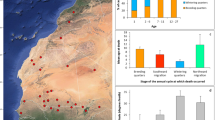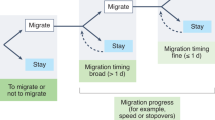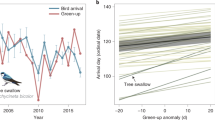Abstract
Buffer effects occur when sites vary in quality and fluctuations in population size are mirrored by large changes in animal numbers in poor-quality sites but only small changes in good-quality sites. Hence, the poor sites ‘buffer’ the good sites1,2, a mechanism that can potentially drive population regulation if there are demographic costs of inhabiting poor sites. Here we show that for a migratory bird this process can apply on a country-wide scale with consequences for both survival and timing of arrival on the breeding grounds (an indicator of reproductive success3,4). The Icelandic population of the black-tailed godwit, Limosa limosa islandica, wintering in Britain has increased fourfold since the 1970s (ref. 5) but rates of change within individual estuaries have varied from zero to sixfold increases. In accordance with the buffer effect, rates of increase are greater on estuaries with low initial numbers, and godwits on these sites have lower prey-intake rates, lower survival rates and arrive later in Iceland than godwits on sites with stable populations. The buffer effect can therefore be a major process influencing large-scale population regulation of migratory species.
This is a preview of subscription content, access via your institution
Access options
Subscribe to this journal
Receive 51 print issues and online access
$199.00 per year
only $3.90 per issue
Buy this article
- Purchase on Springer Link
- Instant access to full article PDF
Prices may be subject to local taxes which are calculated during checkout



Similar content being viewed by others
References
Kluyver, H. N. & Tinbergen, L. Territory and the regulation of density in titmice. Arch. Néerl. Zool. 10, 265–289 (1953).
Brown, J. L. The buffer effect and productivity in tit populations. Am. Nat. 103, 347–354 (1969).
Kokko, H. Competition for early arrival in migratory birds. J. Anim. Ecol. 68, 940–950 (1999).
Møller, A. P. Phenotype-dependent arrival time and its consequences in a migratory bird. Behav. Ecol. Sociobiol. 35, 115–122 (1994).
Pollitt, M. S. et al. The Wetland Bird Survey 1998–99: Wildfowl and Wader Counts (BTO, WWT, RSPB & JNCC, Slimbridge, 2000).
Krebs, J. R. Regulation of numbers in the Great Tit (Aves: Passeriformes). J. Zool. 162, 317–333 (1970).
Ferrer, M. & Donazar, J. A. Density-dependent fecundity by habitat heterogeneity in an increasing population of Spanish Imperial Eagles. Ecology 77, 69–74 (1996).
Fraser, D. & Sise, T. Observations on stream minnows in a patchy environment: a test of theory of habitat selection. Ecology 61, 790–797 (1980).
Halama, K. J. & Dueser, R. D. Of mice and habitats: tests for density-dependent habitat selection. Oikos 69, 107–114 (1994).
Fretwell, S. D. & Lucas, H. J. Jr. On territorial behaviour and other factors influencing habitat distribution in birds. Acta Biotheor. 19, 16–36 (1970).
Underhill, L. G. & Prys-Jones, R. Index numbers for waterbird populations. I. Review and methodology. J. Appl. Ecol. 31, 463–480 (1994).
Sutherland, W. J. From Individual Behaviour to Population Ecology (Oxford Univ. Press, Oxford, 1996).
Moser, M. E. Limits to the numbers of grey plovers Pluvialis squatarola wintering on British estuaries: an analysis of long-term population trends. J. Appl. Ecol. 25, 473–485 (1988).
Goss-Custard, J. D. Competition for food and interference among waders. Ardea 68, 31–52 (1980).
Gill, J. A., Sutherland, W. J. & Norris, K. Depletion models can predict shorebird distribution at different spatial scales. Proc. R. Soc. Lond. B 268, 369–376 (2001).
Kay, D. G. & Knights, R. D. The macro-invertebrate fauna of the intertidal soft sediments of south east England. J. Mar. Biol. Assoc. UK 55, 811–832 (1975).
White, G. C. & Burnham, K. P. Program MARK: survival estimation from populations of marked animals. Bird Study 46, S120–S139 (2000).
Currie, D., Thompson, D. B. A. & Burke, T. Patterns of territory settlement and consequences for breeding success in the Northern Wheatear Oenanthe oenanthe. Ibis 142, 389–398 (2000).
Sandercock, B. K., Lank, D. B. & Cooke, F. Seasonal declines in the fecundity of arctic-breeding sandpipers: different tactics in two species with an invariant clutch size. J. Avian Biol. 30, 460–468 (1999).
Lepage, D., Gauthier, G. & Menu, S. Reproductive consequences of egg-laying decisions in snow geese. J. Anim. Ecol. 69, 414–427 (2000).
Acknowledgements
We are grateful for the financial and technical support of NERC; the TMR programme of the EC through Sandgerdi Marine Institute, Iceland; and A. Gardarsson and the Icelandic Institute of Natural History. We are grateful to L. Norton, J. Smart, D. McNeill, R. Croger, G. Appleton and T. Turner for assistance in the field, and to I. Côté, J. Reynolds and A. Watkinson for comments on the manuscript. Survival data were generated from Farlington Ringing Group and Wash Wader Ringing Group colour-ringing schemes. The FRG scheme is partly funded by the Farlington Ringing Group, Hampshire Ornithological Society and Hampshire County Council. Wetland Bird Survey data were provided by the British Trust for Ornithology.
Author information
Authors and Affiliations
Corresponding author
Rights and permissions
About this article
Cite this article
Gill, J., Norris, K., Potts, P. et al. The buffer effect and large-scale population regulation in migratory birds. Nature 412, 436–438 (2001). https://doi.org/10.1038/35086568
Received:
Accepted:
Issue Date:
DOI: https://doi.org/10.1038/35086568
This article is cited by
-
Stopover-site feather isotopes uncover African non-breeding grounds of migratory passerines
Journal of Ornithology (2023)
-
Small Space but High Diversity: Spatial and Temporal Habitat Use by Endangered Eurasian Curlew at Wintering Sites Throughout Europe
Wetlands (2023)
-
Understanding the impact of recreational disturbance caused by motor vehicles on waterbirds: a case study from the Bundala Wetland, Sri Lanka
Journal of Coastal Conservation (2022)
-
Density-dependent winter survival of immatures in an irruptive raptor with pulsed breeding
Oecologia (2022)
-
Carryover effects of long-distance avian migration are weaker than effects of breeding environment in a partially migratory bird
Scientific Reports (2021)
Comments
By submitting a comment you agree to abide by our Terms and Community Guidelines. If you find something abusive or that does not comply with our terms or guidelines please flag it as inappropriate.



